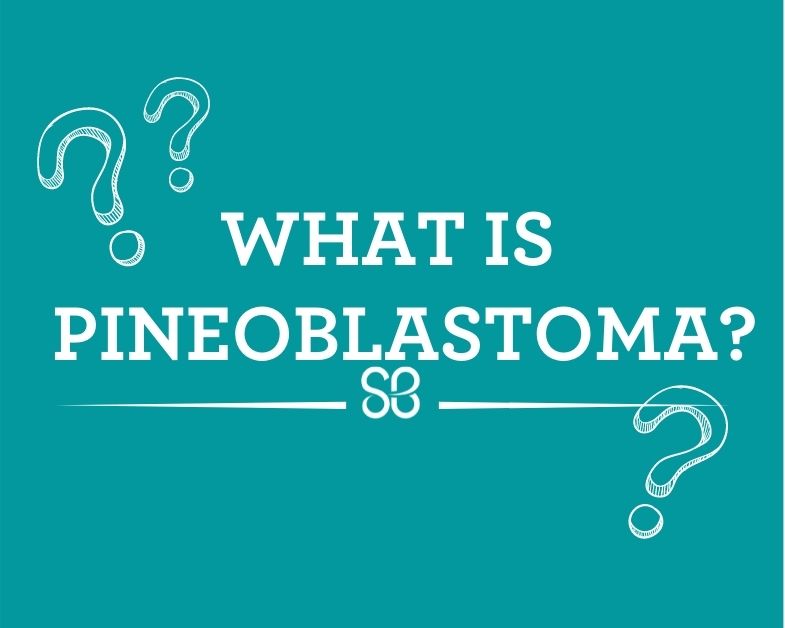
What is pineoblastoma?
The pineal gland is a tiny organ located deep inside the brain that gives off a hormone called melatonin, which controls sleep. One type of tumor that starts in this gland is called a pineoblastoma.
As a group, pineal gland tumors account for less than 1% of all primary brain tumors. Pineoblastomas account for just under half of all pineal gland tumors.
Pineoblastoma is more aggressive than other types of pineal gland tumors. Its fast growth usually causes cerebrospinal fluid (CSF) to build up in the brain. In 10% to 20% of cases the tumors spread to other parts of the body.
The cause of pineoblastoma is not known, although genetic abnormalities are suspected.
What are the signs and symptoms of pineoblastoma?
Because pineoblastomas block the flow of CSF, many symptoms are related to CSF buildup. These symptoms include:
- Nausea and vomiting
- Headache
- Double vision
- Eye movement problems, such as trouble looking up
How is pineoblastoma diagnosed?
Tests and procedures used to diagnose pineoblastoma include imaging tests, biopsy, and lumbar puncture.
- Imaging tests can help determine the location and size of tumor. Often Magnetic Resonance Imaging (MRI) is used.
- Biopsy is a procedure to remove a sample of tissue for testing. The sample is analyzed to determine the types of cells, and level of aggressiveness.
- Removing cerebrospinal fluid for testing, or a lumbar puncture, involves inserting a needle between two bones in the lower spine to draw out cerebrospinal fluid. The fluid is tested for tumor cells and other abnormalities.
What treatment options are available for children with pineoblastoma?
Treatment for pineoblastoma focuses on removing the tumor or reducing its size and managing symptoms. Treatment plans will likely consist of surgery, radiation, and/or chemotherapy.
The average 5-year survival rate of pineoblastoma patients is 58% but drops to 15% in children less than 5 years of age.
How is research helping children with pineoblastoma?
A significant proportion of surviving pineoblastoma patients suffer from severe treatment-related late effects and tumor recurrence. Thus, research into novel therapeutics to improve pineoblastoma patient survival while minimizing adverse side effects is needed.
Researchers are looking at ways to avoid damage to healthy cells during treatment. Sparing healthy cells can reduce long-term treatment-related side effects. Proton therapy is one of the most precise and advanced forms of radiation therapy with pencil-beam scanning that allows for specific treatment of tumors, while sparing surrounding healthy tissues.
Recently, a highly targeted form of proton therapy, known as “FLASH,” with an ultrahigh dose rate, shows less toxicity and improved healthy tissue sparing, while maintaining effectiveness in eradicating tumor cells. St. Baldrick’s Foundation is supporting research into this therapy.
Researchers are also working to determine the effectiveness of combined proton therapy with immunotherapy on pineoblastoma.
We hope this research eventually leads to reduced long-term treatment-related side effects and better survival outcomes for patients with this devastating cancer.
What do researchers need, to make progress faster?
One challenge is obtaining and storing tumor samples, especially from brain tumors. These very small pieces of tumor tissue are valuable for both precise diagnosis and future research, but depending on where the tumor is located, it may not be possible to take them.
When tissue samples are available, it can be difficult for the medical team to ask or — for the family to consider giving — permission to bank those tissues for future research, while everyone is focused on saving a life.
Marisa, mom of pineoblastoma survivor Lauren, says, “One of my biggest regrets is that when Lauren had her surgery, we didn’t save or send tumor tissue (outside of a few slides used for pathology). Not having frozen, unfixed tumor samples has hindered us from a genetics standpoint, getting into a trial and now we have no tissue to donate to the research. I know tumor collection is a huge barrier for research and treatment.” Families who are comfortable doing so can ask their doctor whether it is possible to bank tissue samples without any risk to the child.
And of course, researchers need funding. Lauren’s Pediatric Pineoblastoma Fund is a St. Baldrick’s Hero Fund that has raised more than $100,000 for this research, specifically, to support the research described above.
Donate now to support research to find cures even for the most difficult pediatric brain tumors.
Read more on the St. Baldrick’s blog:

 SBF
Tweets »
SBF
Tweets »